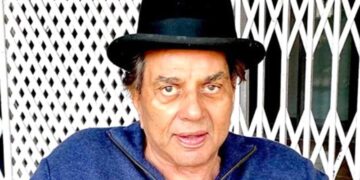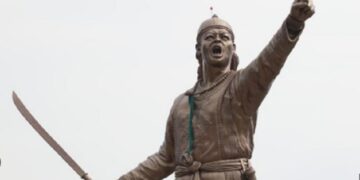Once hordes of Hizbut Tehrir and Jamaat-e-Islami vandals were done with demolishing Bangladesh’s founder Sheikh Mujibur Rahman’s house in Dhaka’s Dhanmondi neighbourhood, a flag belonging to the former fluttered over the ruins of the once-iconic property.
It took no more than seven to eight hours for the unruly and lumpen ‘students’ to nearly flatten 32, Dhanmondi, before torching the remains a second time in six months.
By the time sunlight swept over Dhaka this morning, the memorial took on a grotesque appearance.
The most inglorious part of the willful destruction – the time immediately preceding the vandalism and in the course of the demolition – was the cynical silence of Mohammad Yunus who did not intervene to stop the marauding students from obliterating a symbol of Bangladesh’s liberation as also its tragic history.
Indeed, Yunus, widely viewed by many Bangladeshis as a Clinton family “stooge”, and his other advisor colleagues may have played an active part in the conspiracy to wipe out Mujibur Rahman from Bangladeshis’ collective memory. No arrests have yet been made.
The Bangladesh Army too did not cover itself in glory as a small contingent of soldiers, despatched to the violence site to ostensibly prevent the Hizbut Tehrir and Jamaat cadres from going ahead with their short-notice gratuitous act, convivially mingled with the so-called students bent on giving vent to their uncontrolled fury.
That Bangladesh has descended into chaos was evident from the total absence of the law-and-order machinery, which over the last six months went into obsolescence as a consequence of fear and inertia.
For the student-hordes, the move to demolish Mujibur Rahman’s house was aimed at countering Sheik Hasina’s online address to her Awami League party colleagues and followers in Bangladesh and beyond.
Their mindless violence directed against a structure which, in the aftermath of the August 5 2024 uprising, had already been burned and turned into a public lavatory, was essentially to cover their own misdeeds, failures and schisms.
“Last evening’s violence, sad and unfortunate as it was, should not be seen as part of an isolated event. In fact, similar such acts may be unleashed in the days to come and other sensitive but vulnerable establishments could be targeted,” said Dhaka-based political analyst Nazmul Ahsan Kalimullah.
Many Bangladeshis, especially those who might prefer to describe themselves as members of the intelligentsia, expressed their grief in private for this wanton destruction and that this would have consequences for the Yunus administration.
A former ambassador to a West Asian country who did not want to be identified was scathing.
“Instead of focusing on taking steps to check the economy’s continuing downslide, addressing price rise and building a robust and resilient relationship with Bangladesh’s closest South Asian neighbour, India, the Yunus administration has chosen to direct its energies into violent and potentially destabilising issues that do not bode well for the country,” he said.
Other political analysts were of the opinion that last evening’s “obscene dance of fury” was aimed also to incite anti-India passion that has been rife among a large section of Bangladeshis, particularly those who are easily influenced by Islamist and fundamentalist ideologies.
While the threat to India’s northeast remains as real as ever, since the unruly students took control in August last year, there are reports of “trainings” that Hizbut Tehrir youth are undergoing in Bangladesh’s hilly tracts.
Open threats have been made suggesting that Bangladeshi authorities will permit ULFA ‘commanders’ to “voice their opinions” as a response to Hasina’s address yesterday.
What is equally, if not more, disturbing is that no Awami League worker or supporter descended on Dhanmondi to thwart the combined Hizbut-Jamaat onslaught on Mujibur Rahman’s house. Party workers across Bangladesh are not in any position to reorganise themselves into a potent political force to take on the Hizbut-Jamaat-Islami Chhatra Shibir combine on the ground.
This reticence or unwillingness stems from Awami League leaders’ misdeeds and machinations that enabled them to indulge in corrupt practices, including party “post commerce” at the top and lower organisational rungs.
It is not that the party’s top leadership was unaware of such corrupt practices right down to the ward committee level. This was a singular act of negligence – to put it mildly – on the part of the supine Awami League leadership which took no disciplinary action against those whose hands were in the till. They could not – or did not – act as they themselves were involved in the loot and plunder.
As far as the Awami League is concerned, the party leadership must apportion responsibility for the August 2024 debacle, undertake immediate reforms, especially at the organisation’s central committee level, get rid of deadwood and send out a clear directive that instead of remaining in hiding party leaders must return to Bangladesh and take on the fight – in Dhaka, in the districts, in the sub-districts and in the villages.
ALSO READ: Bangladesh: Awami League needs to regain centre stage
This must be a political battle and not a violent confrontation as Bangladesh has experienced wanton bloodletting in the last six months. Only then would they be able to redeem and preserve Sheikh Mujibur Rahman’s legacy and Bangladesh’s rich secular and cultural tradition.















